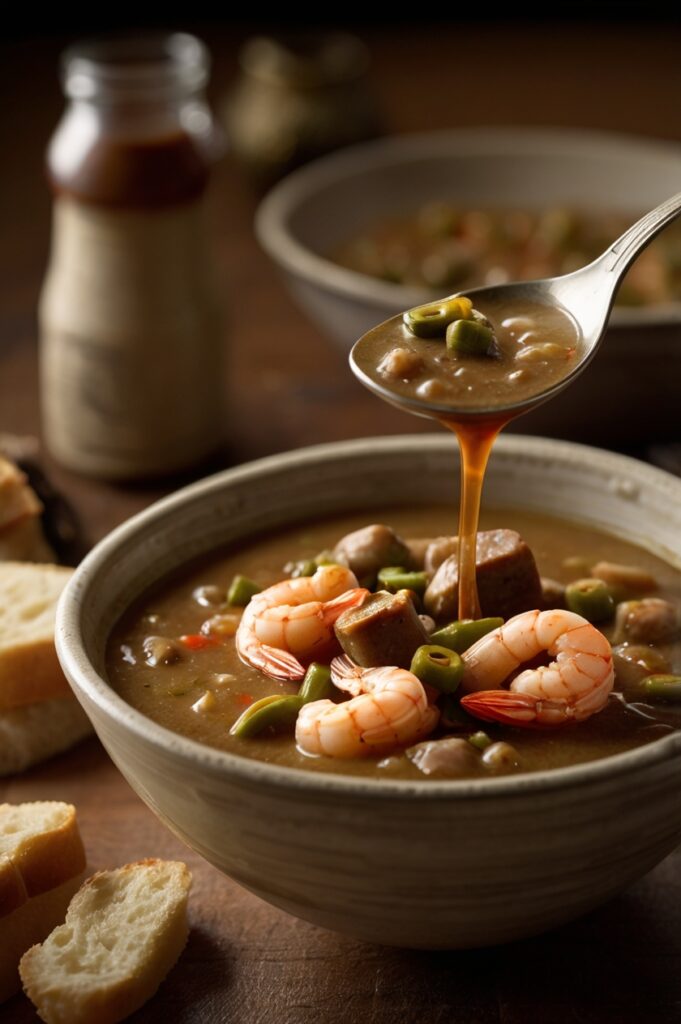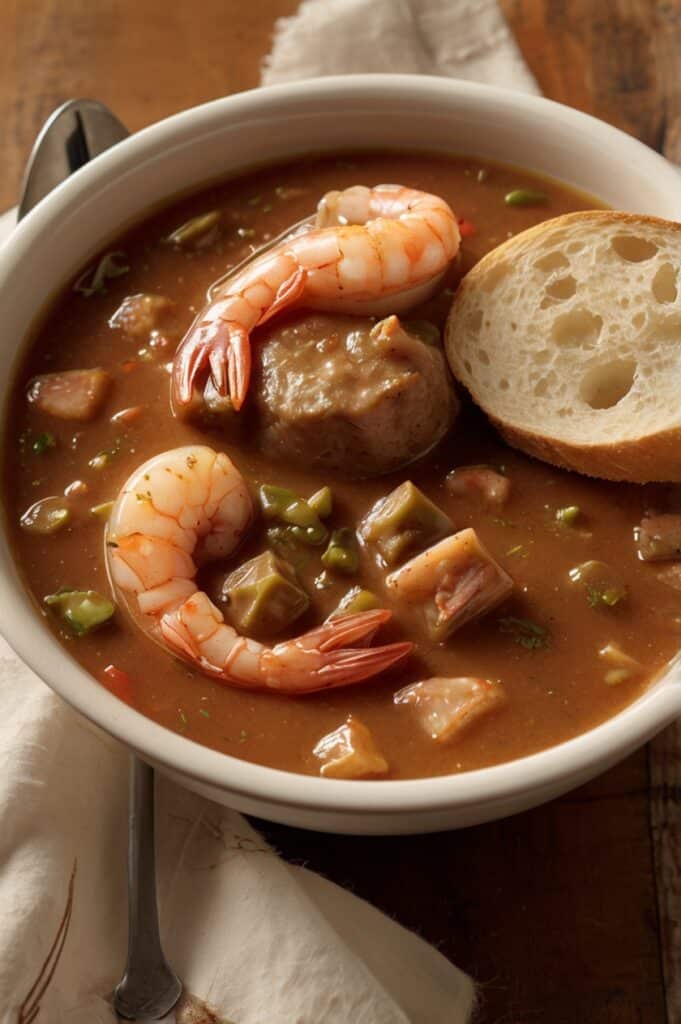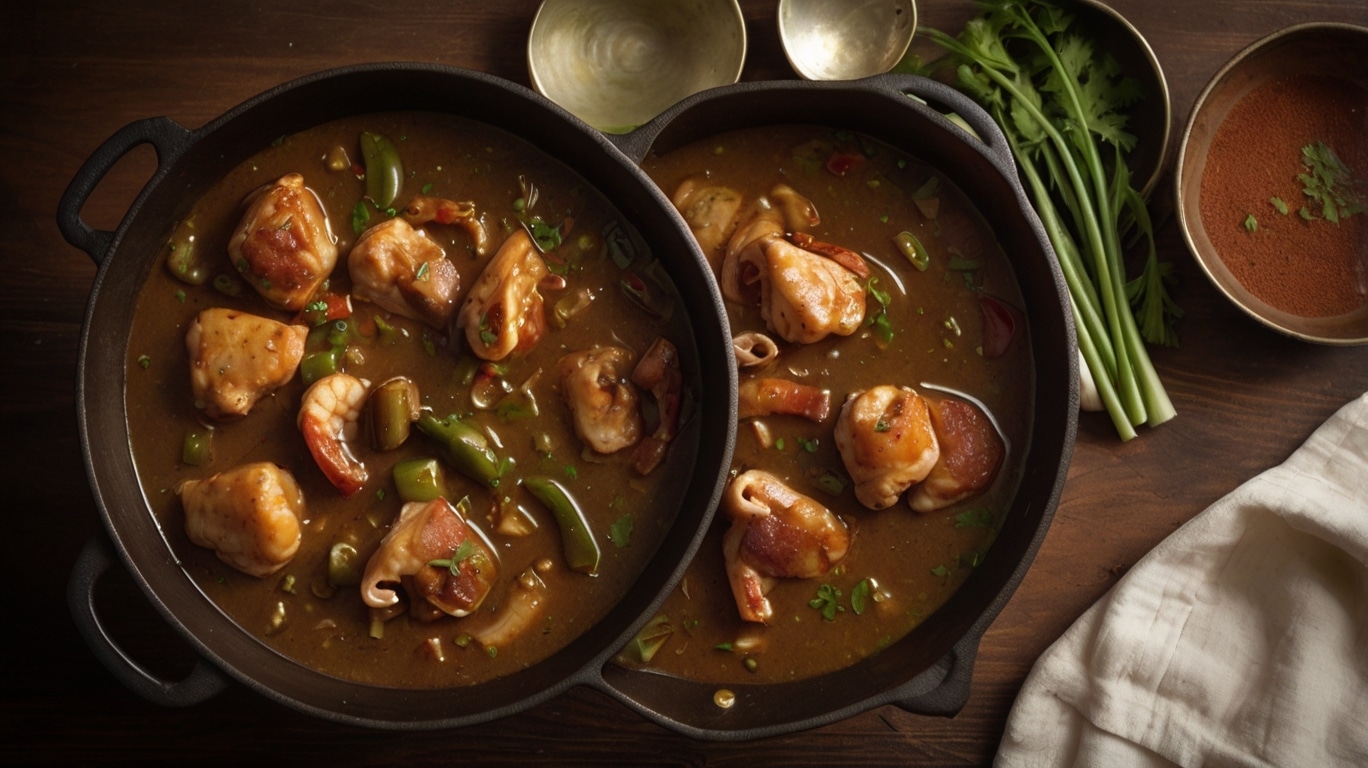It was Mardi Gras morning, I think ’round 7:40 AM, and someone handed me a steaming Styrofoam cup filled with gumbo so rich it nearly made me forget where I was standing. That first spoonful was wild—smoky, deep, shrimp-sweet, chicken-heavy, and dark like midnight coffee. I’ve been chasing that flavor ever since, and I ain’t embarrassed to say I’ve spent years sweating over a bubbling pot trying to recreate it.
Authentic New Orleans Creole Gumbo Recipe isn’t just another stew—it’s a melting pot of culture, history, and serious technique. This one’s not the same as Cajun gumbo, no sir. Creole gumbo’s got that city flair, the roux’s dark as burnt caramel, the tomatoes sneak in, and it carries seafood like royalty. It’s a dish that don’t rush, that don’t fake, and sure as hell don’t cut corners.
Ingredients & Substitutions
Authentic New Orleans Creole Gumbo Recipe starts with a cast of characters that ain’t optional.
- ¾ cup neutral oil (canola or peanut, no olive oil here)
- 1 cup all-purpose flour (not self-rising; roux don’t forgive)
- 1 large onion, diced fine
- 1 green bell pepper, diced
- 3 celery stalks, chopped
- 6 garlic cloves, minced
- 1 lb andouille sausage, sliced
- 1 lb boneless chicken thighs, chopped
- 1 lb raw shrimp, peeled & deveined
- 1 qt seafood stock or chicken stock (homemade’s gold, but boxed can work)
- 1 (14 oz) can crushed tomatoes
- 2 bay leaves
- 1 tsp dried thyme
- 1½ tsp smoked paprika
- ¼ tsp cayenne pepper (or more if ya bold)
- Salt & black pepper to taste
- ½ cup chopped fresh parsley
- 3 green onions, sliced
- Cooked white rice, for serving
- Filé powder, optional, for serving
Substitutions? Alright. Can’t find andouille? Use kielbasa or any smoked sausage, just sear it hard. No chicken thighs? Breast works, but it’ll be drier. Shrimp allergy? Sub with crab or skip altogether. Stock too fancy? Use water + bouillon, but don’t expect magic. No filé powder? Skip it. Gumbo police ain’t real.
Flour-wise, don’t even try whole wheat—gumbo ain’t health food. It’s soul food. All-purpose is the baseline here.

Step-by-Step Instructions
Authentic New Orleans Creole Gumbo Recipe begins with the roux. The heart of it all.
- Make the roux. In a large Dutch oven, heat oil over medium heat. Add the flour and stir constantly—I mean don’t blink—for 25 to 35 minutes. You want a dark chocolate color. Don’t rush or the roux’ll burn and ruin everything. If it smells scorched? Dump it and start again. Ain’t no saving burnt roux.
- Build the trinity. Once the roux hits that perfect mahogany, toss in your onions, bell pepper, and celery. Stir like mad. Let it sizzle for 4–5 minutes till softened and slightly browned.
- Add garlic. Just a minute or two—don’t let it go bitter.
- Drop the meats. Stir in the sliced sausage and chicken pieces. Brown ‘em up a bit. It ain’t searing steak, but some caramelization adds tons of depth.
- Pour in liquids. Add the stock, tomatoes, bay leaves, thyme, paprika, cayenne, and salt. Stir and scrape the pot bottom real good.
- Simmer slow. Bring to a gentle bubble, then lower heat and let it go for an hour, uncovered. You want the flavors to marry like they been dating forever.
- Add shrimp. In the last 10 minutes, stir in the shrimp. Don’t add earlier unless rubber shrimp’s your thing.
- Finish strong. Kill the heat. Toss in chopped parsley and green onion. Stir, taste, and adjust salt or spice.
- Serve with rice, in a deep bowl, with filé powder on the side if you’re using it. A lil’ sprinkle’s traditional.
Mistakes? Easy to make. Don’t undercook the roux—it’ll taste like paste. Don’t add shrimp too early. And don’t forget to season in layers, not just at the end. That’s rookie stuff.
Cooking Techniques & Science
Authentic New Orleans Creole Gumbo Recipe lives or dies by its roux. Let’s be clear: this ain’t a blonde roux. We’re going deep, dark, intense. The science? As flour cooks, the starch breaks down and browns via the Maillard reaction, not caramelization. That’s flavor being built.
Adding the trinity (onion, celery, bell pepper) right after roux? It cools it down just enough to stop it from cooking further, keeps you from burning the flour. And those veggies? They soak up all that roux richness, creating a velvety base.
Simmering low and slow is crucial. You want the meats tender, flavors rich, oils separating slightly on top. Fast cooking gives you soup. Slow cooking gives you gumbo.
Tools? Cast iron Dutch oven or bust. Stainless works but don’t hold heat like cast. You need even cooking here. And a wooden spoon that don’t quit—because you’ll be stirring a whole lot.
Serving & Pairing Suggestions
Authentic New Orleans Creole Gumbo Recipe needs white rice, period. Long-grain’s best—jasmine or basmati’s too fragrant and weirdly sweet for this deep stew. Spoon gumbo over a mound of hot rice, garnish with a dusting of filé or parsley.
Cornbread’s a fine side, if you like a lil’ sweet to go with that spice. Or crusty French bread for sopping—also culturally accurate. Cold beer? Oh, yes. Or sweet tea. Or something citrusy like a whiskey sour to cut the richness.
Don’t overthink plating. Gumbo’s humble. Serve in deep bowls with a heavy spoon. Let the aroma do the fancy work.

Conclusion
Authentic New Orleans Creole Gumbo Recipe is more than food. It’s tradition, a whole-ass story simmered for hours on the stove. If your pot don’t look messy and your kitchen don’t smell smoky-spicy-sweet, you ain’t done it right.
It takes time. Takes patience. But it rewards you like few dishes can. It’s the kind of meal you make to show someone you love ’em, or to feed a crowd when they’re hungry for more than just calories.
Final tip? Make it a day ahead. Gumbo’s always better tomorrow. Something about sitting overnight makes it richer, thicker, deeper.
FAQs
Can I make Creole gumbo without seafood?
Sure thing. Just up the chicken and sausage. You’ll lose some depth, but it’s still rich and hearty.
What’s the difference between Creole and Cajun gumbo?
Creole gumbo usually includes tomatoes and uses a more refined spice blend. Cajun gumbo’s darker, no tomatoes, often spicier and rustic.
How do I store and reheat gumbo?
Cool fully, refrigerate up to 5 days, or freeze for 2–3 months. Reheat gently over low heat. Don’t boil—shrimp gets rubbery.
What’s filé powder and do I need it?
Filé (ground sassafras leaves) thickens and adds an earthy note. It’s optional. Use only after cooking—never boil filé or it gets stringy.
My roux burned. Do I have to start over?
Yep. Sorry, friend. Burnt roux can’t be fixed—it’ll ruin the whole pot. Start fresh. Watch close and stir nonstop.

Olivia P. is a seasoned food blogger at Tastywink, sharing delicious, easy-to-follow recipes inspired by him passion for home cooking. With years of culinary blogging experience, he brings flavor, creativity, and a personal touch to every dish.
